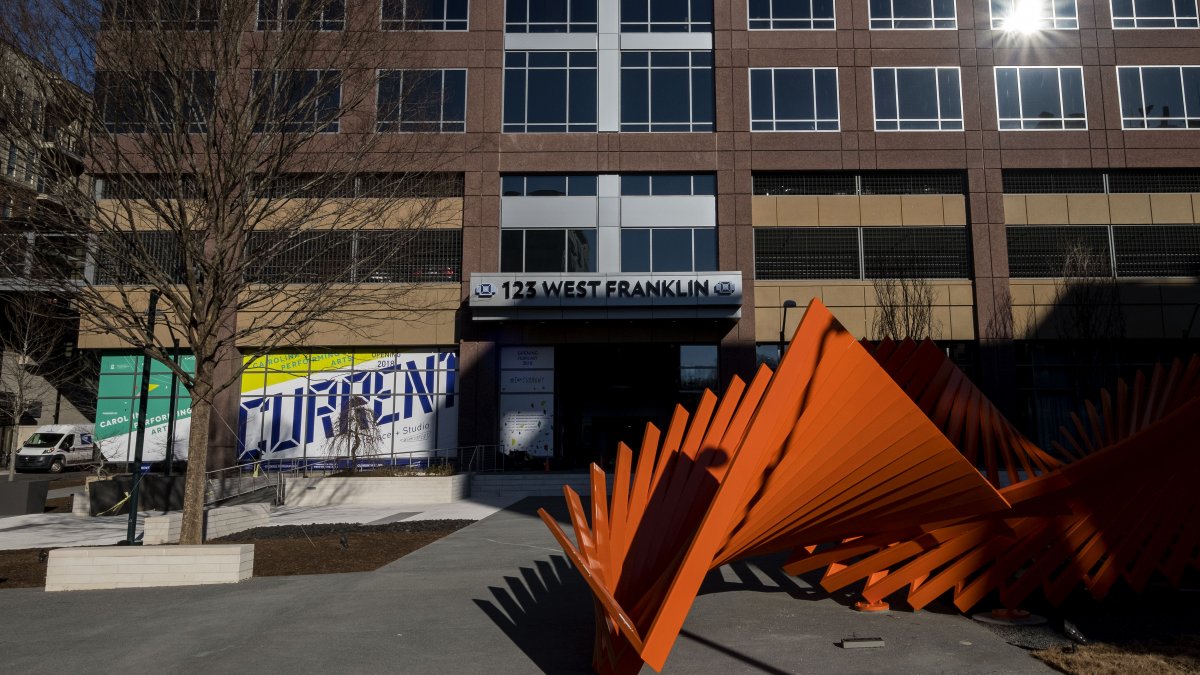Arts unlimited
One of the distinctive features of CURRENT ArtSpace + Studio is that almost nothing qualifies as being behind the scenes or backstage. Those are the kinds of limitations of conventional venues. And CURRENT is nothing if not unconventional.

On Friday, Carolina will open CURRENT ArtSpace + Studio, a flexible and immersive performing arts venue in the heart of the new Carolina Square development on Franklin Street.
At its most basic, CURRENT is a 4,000-square-foot black box theater.
But that’s only the beginning for this unconventional arts venue.
One wall is all glass and the seating can go anywhere (one side to four sides)— or nowhere (completely retractable). It’s a venue more versatile than any other in the area, designed with input from a theater consultant, student groups and University faculty and staff.
This is not to say that Memorial Hall hasn’t been a valuable location for Carolina Performing Arts. As longtime CPA employees, both associate director Mike Johnson and technical director Butch Garris have seen many seasons of successful shows at Memorial Hall, particularly since its nearly $18 million renovation in 2005.
But a big auditorium with a raised stage and fixed seating isn’t ideal for every show. Some require a more intimate setting or a stage that can be easily accessed by the audience or space that can be opened up to the outdoors—or sometimes all of these at once.
One approach they tried at Memorial Hall was what they called “loading dock” shows, in which the audience entered from behind the building and sat on risers on the stage together with the performers. “And every time we do that,” said Garris, “I think how much more incredible it would be in a space that was meant to do that, and that’s what this space is.”
Mixing it up
Each show in CURRENT’s inaugural season requires a different configuration, showcasing the venue’s versatility. Sound Maze, which opens the season, is an installation without seating. The next show will use the seats, but the third one will push back the seats and open up the glass wall to the outside. One concert will be done with the crowd standing in front of the band, like a small club, and one show will have seats on four sides surrounding the stage.
The new venue also drives new programming, in an “if you build it, they will come” way.
“We’re purposefully designing this space to add programming that is more immersive and intimate, so you’re not just close, you’re part of the performance,” said Johnson. CURRENT is also available to rent for the University and local arts community.
The seating is retractable and can be pushed back until it becomes another wall in the room.
The wall of floor-to-ceiling windows includes a section in the center that rolls up and out (somewhat like a garage door). That opens CURRENT to the public space in the heart of Carolina Square, while forming its own awning.
Garris calls the opposite wall the “hard soft” wall. An acoustics expert placed its panels at special angles to deflect the sound off the glass. Each also has a special finish that allows it to be used as a screen for projected images. But the space can easily be returned to black box status by drawing the long black plush drapes to cover the walls.
Then there’s the floor. The swirls in its dark surface may make it look delicate, but it’s tough, made of recycled plastic. Chapel Hill native Michelle Dorrance of the Dorrance Dance Company donned her tap shoes and put it to the test in an out of the way corner—in case she messed up the finish—but she didn’t make a scratch.
Even the ceiling is custom-designed. Each house light is individually controlled, and separate grids with lights, speakers and power outlets give the artists maximum options for lighting and sound effects in
any orientation.
Audience members will also notice differences when they enter the space. The lobby, shared during the day with the office tenants upstairs, has a horizontal strip of five video screens at eye level that can be used in any configuration, from showing one super-wide image to five different info screens.
Those who arrive late for a show will be shown into a special “sound and light lock” space so that their entrance won’t disrupt the performance for others.
Studio space
Across the breezeway is the 3,000-square-foot CURRENT studio space. Although it too can be used for performances, it’s intended to be a place where visiting artists as well as faculty, staff and students can come to rehearse, in full view of the public passing by the floor-to-ceiling glass walls.
The floor of the studio is especially designed for dancers. Its maple surface, stained gray, is a sprung floor over another layer of wood and a layer of rubber, giving dancers the extra bounce they need.
“We had dancers in here and they could actually feel where it started and stopped,” Garris said. “It’s pretty interesting that their feet are that sensitive.”
Johnson is pleased to see CURRENT fulfilling its role in the Arts Everywhere initiative and the Blueprint for Next strategic framework by bringing the arts to the people in the community—office workers, downtown residents and visitors, students in Granville Towers, even random passersby.
“One thing about this project that I think is special is this partnership between the town and the University and a private developer to take this property and turn it into something valuable for all the parties involved,” Johnson said.




